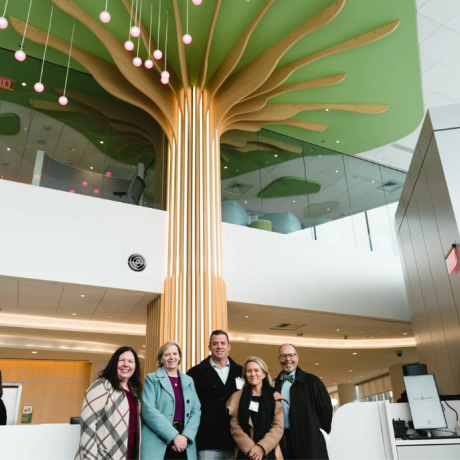The reason pregnancy takes nine months is because that’s how long it takes for a baby’s heart and lungs and brains and other organs and systems to develop to a point where the child can survive in the outside world. When a baby is born short of that nine-month finish line, some of that development is not yet complete. And when a baby is born very early, say, three or four months early, the organs and body systems are nowhere near ready for the outside world. In fact, those babies face a frightening range of challenges, including infections, brain bleeds, lung issues and other problems, many of which can end the baby’s life. That’s why Connecticut Children’s operates multiple Neonatal Intensive Care Units (NICUs) around the state, including a Level 4 NICU in Hartford where the most acutely ill babies receive care.
Of all the dangers a very premature baby faces, perhaps the most worrisome is something called necrotizing enterocolitis (NEC). This condition happens when bacteria in the baby’s intestines attack the lining of the intestines, breaking them down. It affects 5 to 10 percent of babies who are born under three pounds, and it has a mortality rate up to 30 percent. And babies who survive the disease are likely to have lifelong issues, living with large sections of intestines removed and neurodevelopmental problems.
A Terrible Disease
“It’s a very devastating disease when it happens, for the baby and for the families,” says neonatologist Adam Matson, MD, who is conducting ground-breaking research on NEC. “The parents have a 24-week infant and it’s a shock. They weren’t expecting to have a preterm baby at 24 weeks. Usually, the baby requires a placement of an endotracheal tube—you put the baby on a ventilator—and then rush the baby to the Neonatal Intensive Care Unit.”
That’s just the beginning. The first 24 hours are a whirlwind of activity to stabilize and protect the baby. Typically, the baby is given surfactant—the substance that helps lungs stay flexible—and may be given antibiotics to stave off an infection. The team puts in a central line so the baby can get fluids and medications and inserts a feeding tube. Then it becomes a matter of watching and reacting to whatever problems come up. And it may seem that everything is fine.
A Sneak Attack
“Gradually you start to see the parents sort of decompress a little bit,” Dr. Matson says. “They get used to the idea that they’ve had such a fragile infant, and things may be going in a positive direction. We may have been able to wean the baby off a ventilator. Then, at 10 days or 14 days you get called to the bedside because something doesn’t look right. Maybe the abdomen is a little bit distended. Maybe the baby was having some pausing in breathing and needs to go back on a ventilator. The neonatal team typically at that point would probably do some blood work, looking for infection and do some abdominal x-rays. And then the classic diagnostic sign of necrotizing enterocolitis: something that’s called pneumatosis intestinalis—gas inside the intestinal wall.”
The gas comes from fermentation caused by bacteria. Gas is supposed to be inside the tube of the intestines, but if it is inside the intestinal wall, it’s a sign of real trouble: it means the barrier of the intestinal wall, the mucosal layer, is breaking down. The team gives the baby broad-spectrum antibiotics and conducts a series of x-rays to see if that treatment works. And in some cases, it does. But in others, the course is more dangerous. “Sometimes it just goes fast,” Dr. Matson says. “Their bowel can become completely necrotic. It can become a horrendously acidotic because of their microbiome dying.” All bodies produce acid as a result of their functions, and usually any excess acid can be dealt with by body systems. But if the level of acid becomes too high, it can cause serious, even life-threatening conditions. And acid build-up is only one problem.“If they have an intestinal perforation,” Dr. Matson says, “their intestinal wall sort of breaks apart or they may develop something like sepsis. Oftentimes, you need to go to the operating room at that point and have a portion of their intestine removed. It’s a shocker. It’s very difficult to predict which baby in the unit it’s going to happen to. And it always takes the staff aback. It’s difficult for everybody to deal with.”
The Disease that Just Won’t Submit
There has been significant progress in every other part of neonatology, allowing doctors to save babies born earlier and earlier. But the incidence of NEC has not budged in 20 years. In fact, it is exacerbated by the other improvements: the earlier a baby is born, the higher the risk of NEC. That’s why Dr. Matson is conducting research into where it comes from, how it starts and how to stop it.
His research primarily focuses on the microbiome, the complex collection of bacteria and microorganisms that inhabit the intestines and that can have a profound effect on the rest of the body. The microbiome is, in fact, essential for our health (one of Dr. Matson’s research projects, funded by the National Institutes of Health, is focused on the relationship between microbiome and brain development). The microbiome is where NEC gets its start.
The Zoo of You
One important thing to understand is that the microbiome is largely acquired over the first weeks of life, a combination of microbes from the parents, microbes from the milk or formula the baby eats and microbes from their environment. Moreover, the microbiome evolves over time. This is why NEC usually doesn’t show up until the baby is a couple of weeks old.
“We know that microbial colonization is an essential component of the disease,” Dr. Matson says, “but the bacterial species that are involved with it have remained inconclusive. Much of the data we’re seeing supports the idea that NEC is not actually one disease, that it’s actually several different diseases that merged into a common area. So there could be several inciting agents that may ultimately result in this catastrophic end point.”
A Possible Culprit
One of the bacteria that Dr. Matson has found to be a likely candidate is Klebsiella oxytoca. In one study, he and his colleagues found it in six out of ten babies with NEC. “This toxin could actually destroy the intestinal epithelium, sort of melt the protective barrier of the intestinal epithelium,” Dr. Matson says. (The epithelium is a protective layer of cells in the wall of the intestine, letting healthy substances through and keeping harmful ones out.) “Once you start to lose that barrier, a lot of the microbes that are in the intestinal tube can penetrate into the deeper walls of the intestine and then initiate a really profound inflammatory response.”
But it’s not a definitive finding: Klebsiella oxytoca is found in about half of the babies in the NICU, and many of them do not develop NEC. That’s because, like many bacteria, Klebsiella can be a friendly colonizer in certain circumstances but, when the environment changes, its behavior changes, and it becomes pathogenic, releasing cytotoxins. These are substances that destroy cell tissue. Cobra venom, for example, contains very powerful cytotoxins that destroy enough tissue to cause fatal paralysis.. This sort of duality appears to be a hallmark of bacteria. For example, e.coli, the cause of some food poisoning, can sometimes be benign and sometimes toxic.
Bacteria Like Donuts, Too
So what causes the switch? One of the things that Dr. Matson is looking at is nutrition. Researchers have long known that NEC is associated with poor uptake of carbohydrates. Premature babies often have immature digestive enzymes, and their diet is high in carbohydrates, so there is an abundance of carbs in the gut. And that’s good news for Klebsiella.
“Klebsiella absolutely loves to eat sugars,” Dr. Matson says. And when it gets fed sugar it really ramps up cytotoxin production incredibly. Moreover, the cytotoxins they produce actually kill other bacteria. We feel pretty strongly this is a defense mechanism that Klebsiella is using to out-compete other microbes for food. But in the case of the neonatal gut, when this happens, there’s this bystander damage that happens to the intestinal barrier.”
Dozens and Dozens of Cousins
In addition to bacteria having flexible personalities, there is the fact that any given bacteria species may have various strains. Those strains can also behave differently and may play a significant role in NEC development. One of Dr. Matson’s breakthrough discoveries is a method of distinguishing these different strains, using a new DNA sequencing kit and sophisticated data analysis. This level of differentiation was not possible before. It opens the door to a greater understanding of how NEC works.
His most recent research paper, published in MBio, the prestigious journal of the American Society for Microbiology, describes another breakthrough discovery. It involves a chemical compound called indole. It’s defined as an aromatic compound and is found in such unpleasant things as Limburger cheese, decaying flesh and human feces, but also in jasmine flowers, orange blossoms and perfumes. More notably, Dr. Matson and his co-researchers have found it has the happy quality of suppressing the production of cytotoxins in Klebsiella oxytoca in the gut. Human breast milk contains a couple of bacteria species that produce indole, which may be why breast-fed babies tend to have a much lower risk of developing NEC. This new discovery is a crucial step forward in understanding the mechanics of the microbiome and in developing new ways to prevent NEC from developing.
There is still a long way to go before NEC is no longer a threat to premature babies in the NICU, but Dr. Matson’s research is bringing that day much closer.
Like most of the research carried out by Connecticut Children’s physicians and nurses, Dr. Matson’s work depends on philanthropy. His work is supported in particular by very generous gifts from Keith and Catherine Stevenson and by donations from people like you.
Latest Articles

$1 Million Gift from Big Y Supports Connecticut Children's New Clinical Tower and Expanded Pediatric Services

A New Era of Care Begins: Connecticut Children’s Celebrates the Opening of the New Clinical Tower
